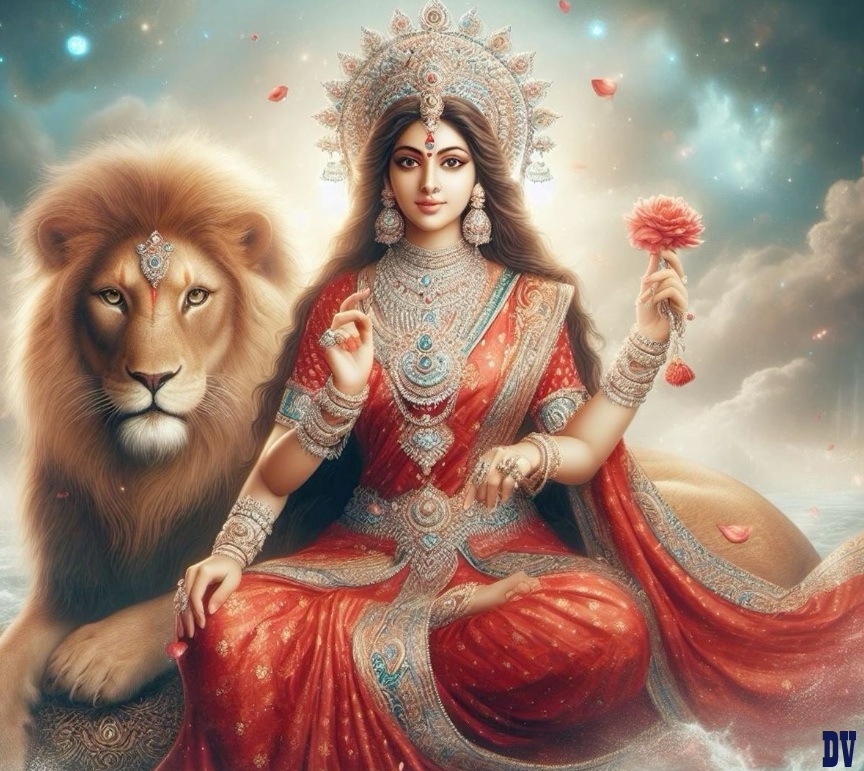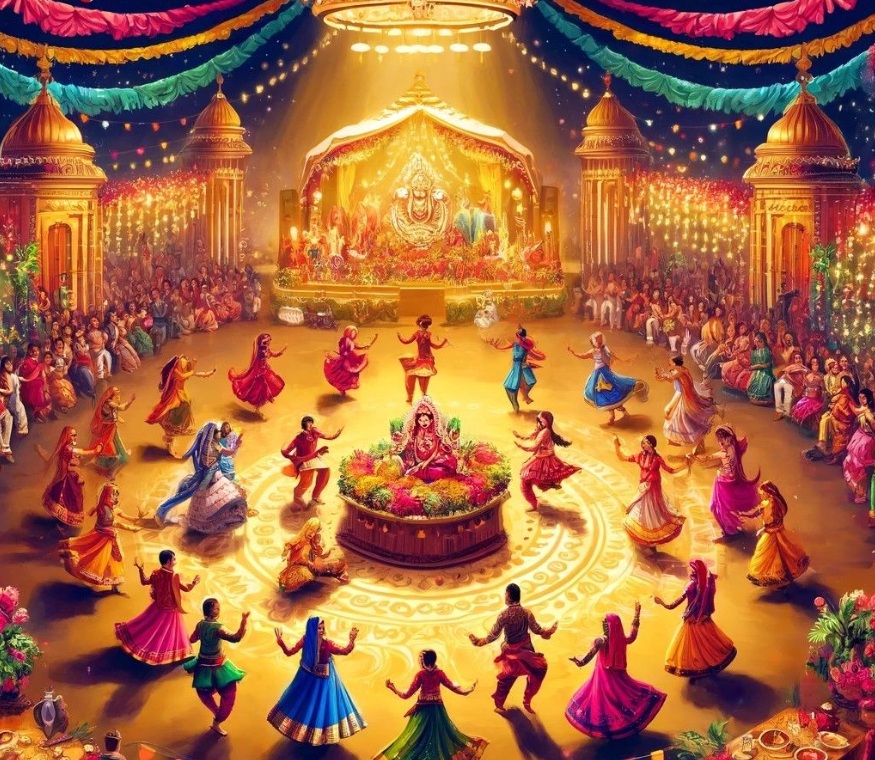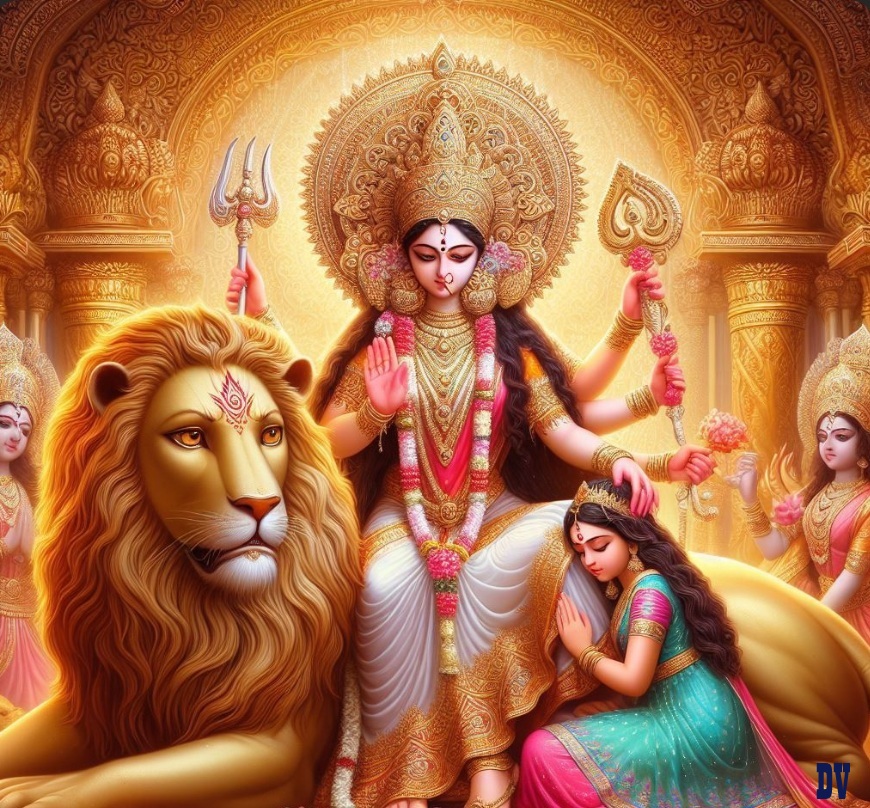Official Website : https://divinenewz.com/
Navratri, a vibrant and deeply spiritual Hindu festival dedicated to the
Divine Feminine, spans nine nights and ten days and is celebrated with unmatched devotion across India and among Hindus worldwide.
“Navratri” means
“nine nights,” during which devotees
worship the nine forms of Goddess Durga. While the festival is
religiously significant, its benefits transcend the spiritual domain—offering mental, emotional, physical, and even social growth.
1. INTRODUCTION
Navratri, one of the most significant Hindu festivals, is celebrated with immense devotion and enthusiasm across India and among Hindus worldwide. Observed twice a year during Chaitra (spring) and Sharad (autumn) seasons, Navratri is a nine-night festival dedicated to the worship of Goddess Durga and her nine divine forms, known as Navadurga. These nine nights are considered highly auspicious and are a time for spiritual awakening, self-discipline, fasting, prayer, dance, music, and celebration. Beyond religious observance, Navratri offers a wide array of benefits that touch upon every aspect of human life—spiritual, mental, emotional, physical, and social.
But Navratri is more than just a religious celebration. It is a spiritual journey, a cultural expression, and a time of inner transformation. To truly understand the meaning of Navratri, one must delve into its spiritual significance, mythological origins, rituals, and its deep-rooted symbolism.
2. MYTHOLOGICAL ORIGINS
According to Hindu mythology, Navratri commemorates the epic battle between
Goddess Durga and the
demon Mahishasura. Mahishasura, a powerful demon, received a boon that no man could kill him. In his arrogance, he waged war against the gods and disrupted the cosmic balance.
The
gods then combined their divine powers to create Goddess Durga, the fierce embodiment of Shakti (energy). The battle lasted nine nights and ten days, at the end of which Durga slayed Mahishasura. This victory symbolizes the
triumph of good over evil, knowledge over ignorance, and dharma over adharma.
3. SPIRITUAL MEANING OF NAVRATRI
Navratri is not merely a festival of rituals—it is a symbolic journey of the soul from darkness to light, from ignorance to knowledge, and from inertia to action.
Each set of three days during Navratri corresponds to a specific spiritual quality:
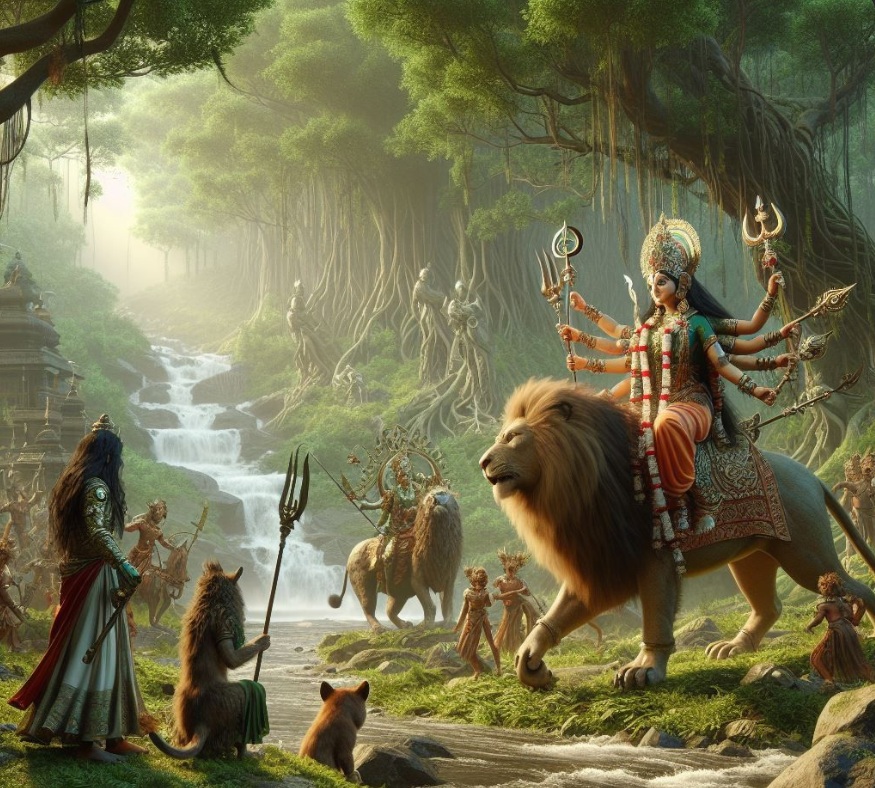
- First Three Days (Tamas – Destruction
These are dedicated to Durga in her fierce forms, such as Kali and Shailaputri, who destroy negativities, fears, and impurities.
- Next Three Days (Rajas – Action)
Worship is offered to Lakshmi, the goddess of prosperity, representing effort, energy, and movement.
- Final Three Days (Sattva – Peace and Wisdom)
Devotees worship Saraswati, the goddess of knowledge and wisdom, to attain inner illumination.
On the tenth day, known as Vijaya Dashami (Dussehra), the victory of divine truth is celebrated.
4. THE NINE FORMS OF DURGA – NAVADURGA
Each night of Navratri is devoted to one form of Goddess Durga:
- Shailaputri – Daughter of the Himalayas; embodiment of purity
- Brahmacharini – Symbol of devotion and penance
- Chandraghanta – Warrior goddess; dispeller of evil
- Kushmanda – Creator of the cosmic universe
- Skandamata – Mother of Lord Kartikeya
- Katyayani – Fierce protector of righteousness
- Kalaratri – Destroyer of darkness and ignorance
- Mahagauri – Radiant with peace and compassion
- Siddhidatri – Giver of spiritual powers (siddhis)
These forms represent the progressive evolution of spiritual consciousness in a seeker.
5. RITUALS AND PRACTICES
During Navratri, devotees engage in various spiritual and cultural practices:
- Fasting and Prayer –
Many observe fasting to cleanse the body and mind, and perform daily pujas.
- Kalash Sthapana – A sacred pot is placed and worshipped as a symbol of creation.
- Kanya Puja – On the 8th or 9th day, young girls are worshipped as the embodiment of divine energy.
- Garba and Dandiya – Especially in Gujarat, devotees celebrate with dance and music, symbolizing the cosmic rhythm.
- Recitation of Scriptures – Texts like
Durga Saptashati or
Devi Mahatmya are read.
6. CULTURAL MEANING AND CELEBRATIONS
Navratri has diverse regional interpretations across India:
- In Gujarat,
it is famous for Garba and Dandiya Raas, traditional group dances performed in circles.
- In Tamil Nadu,it includes Golu—a display of dolls representing divine themes and mythological stories.
- In North India, Ramlila plays are staged, and effigies of Ravana are burnt on Dussehra.
- In Maharashtra, homes are decorated and the goddess is worshipped with daily rituals and colors.
7. SYMBOLISM OF NAVRATRI
Navratri is filled with symbolic meaning:
- Nine Nights :
Represent the time needed to overcome internal demons and cultivate divine qualities.
- Colors :Each day is associated with a specific color symbolizing different energies like courage, devotion, love, and knowledge.
- Dance :The Garba circle represents the universe, and the central lamp symbolizes divine energy.
- Fasting : Helps detox the body and discipline the senses, aligning with spiritual practices
8. PSYCHOLOGICAL AND INNER MEANING
Navratri also has deep psychological relevance :
- Destruction of Inner Negativity :
It’s a time to destroy ego, anger, greed, and other negative traits.
- Awakening of Shakti (Energy):The divine feminine represents our inner strength and creative force.
- Dance :The Garba circle represents the universe, and the central lamp symbolizes divine energy.
- Fasting : Helps
detox the body and discipline the senses, aligning with spiritual practices
This article explores 156 powerful benefits of observing Navratri, shedding light on why millions await this sacred time each year and how it can enrich our lives in multifaceted ways.
1.SPIRITUAL BENEFITS OF NAVRATRI
- Connection with the Divine :
Navratri is a time to connect deeply with the
divine feminine energy, enhancing one’s
spiritual consciousness.
- Deepens connection with the
Divine Mother.
- Chakra Balancing:Chanting
mantras, meditation, and devotional practices help
activate and balance chakras.
-
Purifies the soul and raises
spiritual consciousness.
- Encourages
introspection and self-realization.
- Strengthens
devotion and bhakti (faith).
- Aids in
spiritual awakening.
- Cleanses
negative karma
- Invokes the
Shakti (divine energy) within.
- Accelerates progress on the
path of Moksha (liberation).
- Enhances
meditation and sadhana effectiveness.
- Energizes all
chakras through mantra and fasting.
-
Strengthens one’s aura.
- Helps
overcome tamas (inertia) and rajas (restlessness).
- Brings
peace, purity, and sattva (balance).
- Establishes a
rhythm with cosmic cycles.
- Awakens dormant
spiritual powers (siddhis).
- Encourages regular
prayer and discipline.
- Develops reverence for divine feminine forces.
- Makes one receptive to divine grace.
- Purifies
home and personal energy.
- Removes
spiritual blockages.
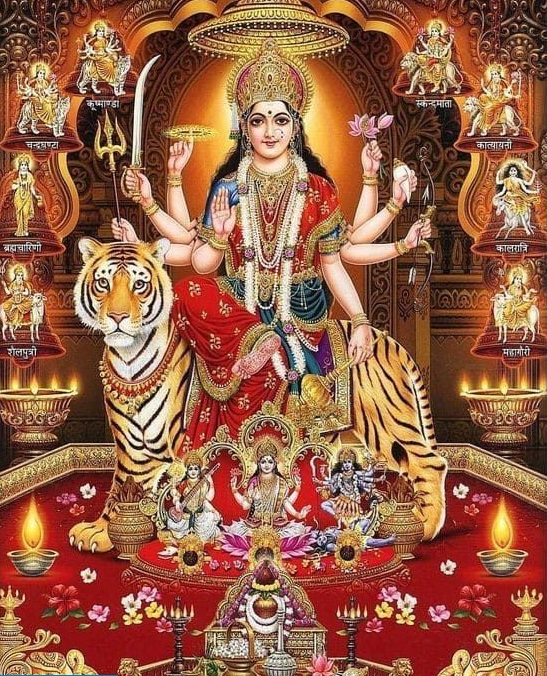
2. PSYCHOLOGICAL AND MENTAL HEALTH BENEFITS
- Promotes mental clarity.
- Helps in overcoming depression and anxiety.
- Reduces stress levels.
- Enhances willpower through fasting and restraint.
- Builds mental discipline and focus.
- Cultivates positive thinking.
- Encourages inner peace.
- Eliminates emotional toxins.
- Improves patience and tolerance.
- Brings emotional balance.
- Boosts confidence through spiritual self-esteem.
- Decreases overthinking and mental fatigue.
- Strengthens intuition.
- Uplifts mood naturally
- Restores a sense of purpose.
- Builds a strong inner core.
- Encourages a break from worldly distractions.
- Enhances resilience to life’s challenges.
- Promotes mindfulness.
- Supports mental transformation.
3. PHYSICAL HEALTH AND WELL-BEING BENEFITS
- Detoxifies the body through fasting.
- Improves digestion by giving rest to the gut.
- Enhances immunity.
- Regulates metabolism.
- Promotes weight management.
- Clears skin and improves complexion.
- Reduces cravings for junk food.
- Encourages a satvik (pure) diet.
- Boosts energy naturally.
- Improves sleep quality.
- Balances hormonal function.
- Supports liver health.
- Encourages healthy hydration.
- Helps manage chronic diseases.
- Reduces inflammation.
- Improves mental alertness.
- Regulates blood sugar levels.
- Supports heart health.
- Promotes physical flexibility through dance and garba.
- Improves overall vitality.
4. SOCIAL AND COMMUNITY BENEFITS
- Brings people together through collective prayer.
- Strengthens community bonds.
- Fosters cultural identity.
- Promotes unity in diversity.
- Encourages sharing and seva (service).
- Builds harmony in families and neighborhoods.
- Offers platforms for artists, musicians, and dancers.
- Enhances social celebrations and joy.
- Strengthens moral and ethical values.
- Provides collective healing through rituals.
- Encourages traditional attire and pride in culture.
- Builds networks of spiritual support.
- Promotes intergenerational bonding.
- Involves youth in spiritual activities.
- Supports artisans through festive markets.
- Preserves folk arts and regional traditions
- Enhances participation in community service.
- Fosters empathy and charity.
- Supports local economy via festivals.
- Celebrates collective dharma and spirituality.
5. EMOTIONAL AND ENERGETIC HEALING BENEFITS
- Helps release suppressed emotions.
- Transmutes grief into spiritual strength.
- Supports trauma healing through devotion
- Creates a safe emotional space for self-reflection.
- Enhances self-love through goddess worship.
- Transforms fear into courage.
- Removes emotional toxicity.
- Balances masculine and feminine energies.
- Encourages forgiveness.
- Inspires hope and renewal.
- Breaks emotional dependencies.
- Awakens compassion.
- Strengthens the heart chakra.
- Brings tears of release and joy.
- Clears old relationship patterns.
- Boosts vibrational frequency.
- Encourages healing rituals.
- Brings catharsis through devotional songs.
- Uplifts the spirit through collective joy.
- Cultivates emotional maturity.
6. RITUALISTIC AND DEVOTIONAL BENEFITS
- Teaches the value of puja (ritual worship).
- Instills discipline through daily rituals.
- Brings deeper understanding of Vedic traditions.
- Connects devotees to powerful mantras.
- Encourages home altar worship.
- Enhances sankalpa shakti (power of intention).
- Revives the knowledge of Devi Mahatmya and scriptures.
- Strengthens family participation in rituals.
- Preserves ancient Vedic knowledge.
- Teaches traditional stories of Goddess Durga.
- Enhances power of havan (fire ceremony).
- Reinstates devotion in daily life.
- Makes prayer a habit.
- Awakens sacredness in everyday acts.
- Helps set and fulfill spiritual goals.
- Strengthens ritual purity.
- Inspires cleanliness and order.
- Invokes blessings from the divine mother.
- Teaches humility and surrender.
- Offers experience of divine presence.
7. PERSONAL DEVELOPMENT AND LIFE SKILLS
- Teaches time management.
- Fosters consistency in habits.
- Improves self-discipline.
- Enhances gratitude.
- Strengthens
values and character.
- Promotes simplicity in living.
- Reduces ego and pride.
- Encourages detachment from materialism.
- Inspires lifelong learning of dharma.
- Teaches service over selfishness.
- Fosters compassion in leadership.
- Encourages healthy routines.
- Makes you more tolerant of others.
- Helps in overcoming vices.
- Builds capacity for silence and listening.
- Enhances moral decision-making.
- Encourages living a purpose-driven life.
- Promotes giving over hoarding.
- Inspires role modeling for children.
- Helps overcome laziness and lethargy.
8. UNIQUE AND SUBTLE BENEFITS OF NAVRATRI
- Increases the sattvic vibrations in the home.
- Brings prosperity and abundance.
- Removes obstacles from one’s path.
- Attracts divine blessings and grace.
- Awakens the inner goddess in women.
- Honors the feminine energy in all beings.
- Supports ancestral healing and blessings.
- Encourages eco-conscious celebrations.
- Aligns you with cosmic energies.
- Increases devotion to dharma.
- Prepares one for the festival of Dussehra (symbol of victory).
- Invokes blessings for protection from negativity.
- Recharges all levels—body, mind, and soul.
- Makes life more
sacred, beautiful, and divine.
9. CONCLUSION
Navratri is more than a religious festival—it’s a divine opportunity to transform one’s inner and outer world. Observing Navratri with sincerity and devotion unlocks a vast spectrum of blessings, from physical health and mental clarity to spiritual elevation and emotional healing. The 156 benefits listed above represent just a glimpse into the infinite grace available during these sacred nine nights.
Navratri is not just a religious event—it is a multi-dimensional spiritual experience. It reminds us of the infinite power of the feminine, the cyclical nature of life, and the inevitable victory of truth.
By celebrating Navratri with devotion, introspection, and joy, one aligns with the universal rhythm of transformation and renewal. It is a sacred opportunity to connect with the divine within and around us, empowering us to emerge stronger, purer, and wiser.
Navratri is a call to awaken the Durga within.
10. WRAPPING UP
We hope this has tried to clear up some of the confusion about
Navratri. First of all, you will have to know about the meaning of Navratri, Navratri serves as a
spiritual journey inward, invoking the divine feminine to cleanse our inner world and guide us towards righteousness, prosperity, and wisdom. And also explains the benefits of Navratri for every aspect of life. By celebrating Navratri with devotion, introspection, and joy, one aligns with the universal rhythm of transformation and renewal.
Navratri literally means “Nine Nights.” It is dedicated to Goddess Durga and her nine forms (Navadurga), just like other Navratris, but the key difference is the focus on inner spiritual practices, tantra sadhana, and occult rituals. The main aim of Navratri is inner transformation, spiritual elevation, and tantric sadhanas. Devotees engage in specific rituals, mantra chanting, and practices to please the Goddess and awaken the Kundalini Shakti—the latent spiritual power within.
You still have any question, feel free to ask me via comments or via email.
Don`t forget to share what you like here on Youtube, Facebook, Instagram with your friends and family.
At DivineNewz, a spiritual and temples news related information providers, is working on the project to work for religion and information about the temples to share with you to bring new ideas about spiritual and religious world.
Get in touch with DivineNews by contacting by divinenewz6@gmail.com/ For more information, please visit:
https://www.divinenewz.com
May the light of the Divine Mother illuminate your path during every Navratri and beyond.
Jai Mata Di!
ARTICLE WRITTEN BY:
Divinenewz is a firm Working very proficiently for sharing the divinely knowledge, darshan and pilgrim details and many more in spiritual field. If you have any unique temple and divine place around the globe, then contact us at divinewisdom0608@gmail.com, divinenewz6@gmail.com, or
For more information, please visit:
https://www.divinenewz.com
what is Navratri?
Navratri, a vibrant and deeply spiritual Hindu festival dedicated to the Divine Feminine, spans nine nights and ten days and is celebrated with unmatched devotion across India and among Hindus worldwide. “Navratri” means “nine nights,” during which devotees worship the nine forms of Goddess Durga.
What is Spiritual Meaning of Navratri?
Navratri is not merely a festival of rituals—it is a symbolic journey of the soul from darkness to light, from ignorance to knowledge, and from inertia to action.
What are the Nine Forms of Durga?
Each night of Navratri is devoted to one form of Goddess Durga:
Shailaputri – Daughter of the Himalayas; embodiment of purity
Brahmacharini – Symbol of devotion and penance
Chandraghanta – Warrior goddess; dispeller of evil
Kushmanda – Creator of the cosmic universe
Skandamata – Mother of Lord Kartikeya
Katyayani – Fierce protector of righteousness
Kalaratri – Destroyer of darkness and ignorance
Mahagauri – Radiant with peace and compassion
Siddhidatri – Giver of spiritual powers (siddhis)
These forms represent the progressive evolution of spiritual consciousness in a seeker.


